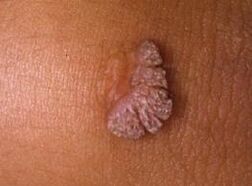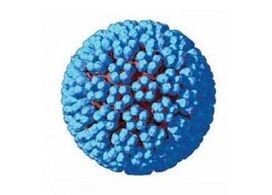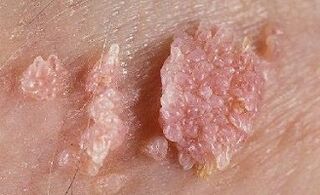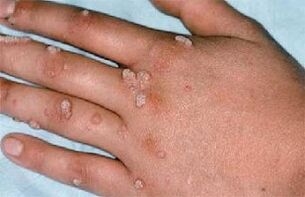
Human papillomavirus (HPV) is a highly human-specific infection belonging to the family Papovaviridae that has the ability to infect and transform epithelial cells.More than 100 types of HPV have been identified, 35 of which infect the human urogenital tract, causing damage to the skin epithelium and reproductive organ mucosa.
According to the World Health Organization, one in six people is a papillomavirus carrier.The infection caused by the papillomavirus is warts (condyloma acuminata), a viral infectious disease characterized by the appearance of papillomatous structures on the skin and mucous membranes.HPV is characterized by its chronic form and its constant recurrence.
reason
Why does human papillomavirus appear?what is it?The causative agent is a virus that affects the upper layers of the skin and the mucous membranes of the reproductive organs.These viruses can only be transmitted from person to person; infection occurs through contact with a sick person's skin or mucous membranes.
Human papillomavirus infection may occur:
- during sexual intercourse.According to the International Medical Association, papillomavirus is one of the most common sexually transmitted diseases, accounting for more than 60% of cases.
- at birth.The infection can be transmitted from mother to newborn at birth, subsequently leading to papillomavirus or laryngeal papillomatosis infection.
- With autologous vaccination function.Self-infection can occur if you do not follow the basic rules of hygiene: hair removal or shaving.
- through daily means.Human papillomavirus has a strong survivability and can survive for a long time in warm and humid environments such as toilets, bathrooms, gyms, swimming pools and other public places.Infection occurs through direct contact, use of personal hygiene products, or through various skin lesions in public places.
Different types of HPV can cause or be involved in the following diseases:

- cervical dysplasia (62%);
- Preinvasive and invasive cervical cancer (38%);
- Genital warts, urinary tract (51%);
- 10% of clinically healthy women are HPV carriers;
- In 85% of patients with classic external genital warts, examination reveals foci of severe and mild HPV infection in the vagina and cervix.
These data allow us to consider patients with genital tract human papillomavirus infection as a high-risk group for cervical intraepithelial cancer.
Classification
The following categories apply:
- HPV, which manifests itself as various types of warts (HPV 1-5):
- Plantar warts (callus-like appearance), HPV types 1-4;
- Flat warts are HPV types 3, 10, 28, and 49;
- Common warts are HPV type 27.
- HPV types that affect the vulva, vagina, genitals, cervix, and respiratory tract are HPV types 6, 11, 13, 16, 18, 31, 33, 35.
- Rash-like lesions of HPV are associated with precancerous conditions (high-risk HPVs), including HPV 39 and other types.
As you can see, these benign tumors can form anywhere in the body:
- neck;
- Face;
- under the breast;
- under the arm;
- on genitals;
- Mucous membranes of the internal organs, mouth and nose.
The need to treat human papillomavirus is due to the following facts.This strain is an intracellular parasite and cannot reproduce independently.For these purposes, it uses human cells.The virus can remain parasitic for quite some time, introducing its own DNA into human chromosomes.Its clear activation is observed against a background of reduced immunity.
incubation period
Long incubation period: half a month to several years.Human papillomavirus infection is characterized by an insidious (latent) course.A person can be infected with multiple types of papillomavirus at the same time.Under the influence of various factors, the virus is activated, multiplies, and the disease enters the clinical manifestation stage.
In most cases (up to 90%), spontaneous recovery occurs within 6-12 months, in other cases there is a long-term chronic relapsing process, and this process can become malignant (depending on the type of virus).
Human papillomavirus symptoms
The human immune system is strong enough to defeat viruses in their early stages of development.In most cases, the disease does not progress.However, over time, months, years, or even decades, people may develop some symptoms of HPV infection.
There are several types of diseases most commonly caused by HPV:
- wartThey are round growths, stronger than the body and 2 mm to 1 cm in diameter.The borders of the warts are very clear and the warts are found to be irregular in shape.They are rough to the touch and can come in different colors.They are most common where the skin is most damaged: the hands, knees, or elbows.
- plantar warts.This condition occurs when the areas where shoes rub or press against the foot become infected with the Type 1 and Type 2 viruses.The skin at the site of the wart becomes thicker and the wart has no clear boundaries.
- genital warts– Special warts that usually appear on the mucous membranes and skin of the reproductive organs: the skin of the glans penis and foreskin in men, the skin of the labia in women.They may also appear in the bladder, urethra, cervix, vagina, skin around the anus, and mouth.Externally, these genital warts look like small raised structures with uneven edges (looking like cauliflower).The disease is caused by human papillomavirus types 6 and 11.
- Bowenoid papulosis.Small, flat wart patches (somewhat similar to flat warts) appear around the genitals.Men who frequently change sexual partners are more likely to develop this condition.Called by type – 16, 18, 31, 33, 42, 48, 51, 54.
Any viral infection that persists in a person's body (HPV is one of them) only becomes activated when immunity weakens.
Human papillomavirus: photos

To understand the various manifestations of human papillomavirus, we have prepared a photo.
Symptoms of human papillomavirus infection in women
The infection may occur in a latent form or may lead to the development of genital papillomas.Genital warts are mainly seen in women between the ages of 15 and 30.
The main risk of developing the disease caused by types 16 and 18 is cervical cancer.Cervical cancer shortens life expectancy by an average of 26 years.From a cancer development perspective, only viruses that remain in the body for more than a year become dangerous.
Unfortunately, symptoms of these conditions in women often don't appear until the final stages, when treatment is significantly less effective.
Symptoms of human papillomavirus infection in men
Human papillomavirus is less dangerous for men than for women.Most often, they are passive carriers.The likelihood of developing cancer is much lower.
HPV in men can cause genital warts on the foreskin, glans penis, or frenulum.Such structures must be urgently removed as they not only interfere with personal hygiene but also interfere with sexual activity.
prevention
We list the main directions for preventing human papillomavirus infection:
- Personal hygiene measures in public places;
- A healthy lifestyle to maintain high levels of immunity;
- Correct work and rest times;
- Moderate physical training;
- Take vitamins, fruits, juices;
- Only one sexual partner (ideally);
- Use condoms during sex.
Currently, there is a vaccine against human papillomavirus.
Human papillomavirus treatment
Currently, there is no antiviral drug that can make human papillomavirus disappear from the body.
Various interferons and pro-interferons can reduce existing genital warts but do not reduce the frequency of new genital warts forming.Therefore, the mainstay of treatment for human papillomavirus remains chemical or surgical removal of genital warts.
The following are the main methods of removing papilloma tissue:
- radiosurgery.Radio wave electrodes cut through tumors and coagulate blood vessels.An antibacterial bandage will then need to be applied.
- laser.Non-contact, bloodless method.A layer of hard skin will be left at the site of the removed papilloma, under which healing will occur.Disadvantages: Risk of recurrence, high cost, and the need to polish residual scars.
- electrocoagulation.This method is similar to the previous two methods in terms of efficiency, results and price.
- surgical.This is a procedure performed under local anesthesia.

Before starting treatment, be sure to ask your doctor:
- What treatments are offered at the clinic where you were treated?
- How much does each treatment cost and what are the possible complications?
- Will the surgery be painful?
It must be emphasized that removal of papillomas should not be considered a complete cure for human papillomavirus infection, since in this case the person does not cease to be a carrier of the virus, that is, papillary polyps may reappear within a few years.That is why, for prevention purposes, doctors recommend improving the health of the entire body.
freeze solidification
Cryocoagulation (liquid nitrogen cauterization) is a quick and effective method of treating genital warts.The procedure can be somewhat painful and unpleasant, but it rarely causes much trouble for the patient.
Cryotherapy for genital warts needs to be done in several sessions over several weeks.Complete elimination of genital warts is observed in 75-80% of patients undergoing all surgeries.
Advice to patients
You should not try to diagnose and treat human papillomavirus yourself.
- First, you need to choose the right method.
- Second, there is always a risk of confusing genital warts with malignancy.
It's best not to take any chances and trust your health to professionals - this will ensure you have a long and happy sex life.Withhold sexual activity during papillomavirus treatment until complete recovery.It is necessary to examine the partner and, if necessary, to treat it.























